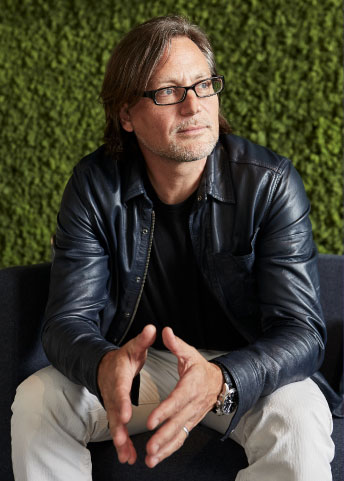Leading Through the Power of Design
Steelcase VP of Global Design and Product Engineering James Ludwig talks about his innovative Brand and Design Leadership course for students in Northwestern's Engineering Design Innovation (EDI) program.
 Steelcase is the largest manufacturer of office furniture in the world, and as vice president for global design and product engineering, James Ludwig likes to say he and his team are responsible for everything the company does that's three-dimensional — products, showrooms, pop-up retail sites, and even spaces where Steelcase employees work.
Steelcase is the largest manufacturer of office furniture in the world, and as vice president for global design and product engineering, James Ludwig likes to say he and his team are responsible for everything the company does that's three-dimensional — products, showrooms, pop-up retail sites, and even spaces where Steelcase employees work.
"We are the body language of the brand," Ludwig said. "We make insights tangible."
This past spring, Ludwig joined Northwestern's Engineering Design Innovation (EDI) program as an adjunct faculty member to help share his knowledge and experience with current students. He taught a new course called Brand and Design Leadership that went so well he will teach it again in spring 2022.
Ludwig recently sat down to talk about the course, leadership, and why learning from failure is key to innovative design.
What is the goal of your Brand and Design Leadership course?
I wanted to present some frameworks, tools, and approaches that the cohort could use to decode its interactions with brands, products, and experiences. If design is about seeing the everyday in new ways, I wanted to help develop a new lens to do this. That’s a way to gain insight into how to transform — or at least participate in shaping — the world around us through the power of design.
It was also important to discuss various ways leaders impact the people around them. I wanted to present unconventional models of leadership and discuss them – including breaking down the lives and career journeys of some amazing leaders — and then connect our own personal journeys to those principles. I wanted to challenge some of the conventional notions of what leadership is and what leaders do.
What traits do you think are essential for an effective leader?
I’m convinced that the notion of effective leadership has fundamentally changed. When I started out, it seemed leaders knew stuff and they told you stuff. The more effectively that leaders projected and imparted certainty, the more they were judged to be effective leaders. I think it’s different, or at least my experience has shifted. Leaders still know stuff and share stuff, but it’s clear that the most effective ones are incessantly curious to learn more and share that contagious curiosity and inquiry. Effective leaders inspire followership — as opposed to grabbing the mic and demanding it. I prefer working with people like this and find innovation thrives in this kind of culture.
What does it take to be an effective designer?
I read something that referenced “High Empathy. Low Ego.” I think what that was saying is that design is about real inquiry and problem-solving — and of course mad skills to turn mysteries into tangible things, services, and experiences. So what does it take to be an effective designer? Curiosity, empathy, “pounce-factor,” a lack of contentment with the status quo, and it helps to develop a superpower skill or two.
How important are the concepts of experimenting, failing, and learning to being a good designer?
Fundamentally, that is the process of design and innovation. There is no certainty and no precedence when you are doing something for the first time. You’re going to have to get used to being wrong a lot. But when you’re right, it’s so much more rewarding. Get comfortable with the ambiguity of it all, but not too comfortable because we still want to see amazing outcomes. It’s just not linear and certain.
What excites you about EDI?
I think EDI owns a special place of nurturing inquiry and exploration while recognizing that we impact people in real and tangible ways with our work. It’s the kind of program I wish had been around when I was a student.

